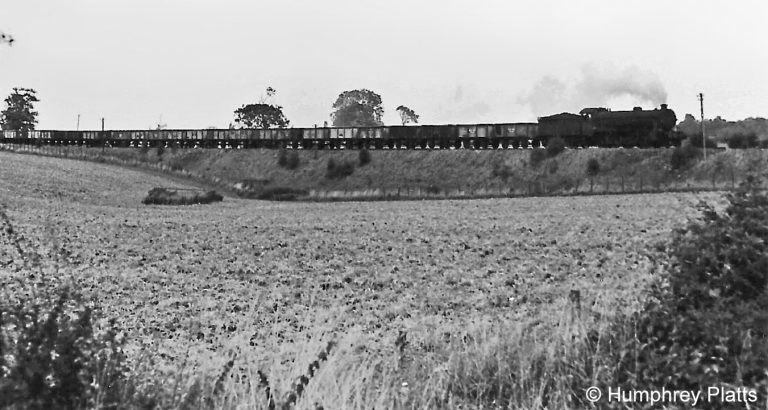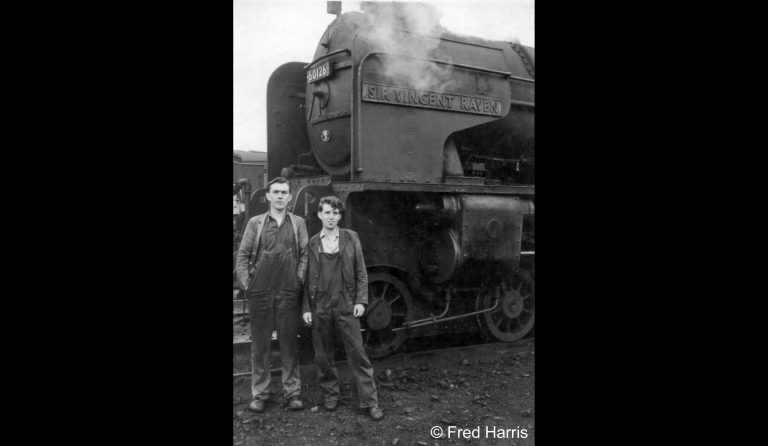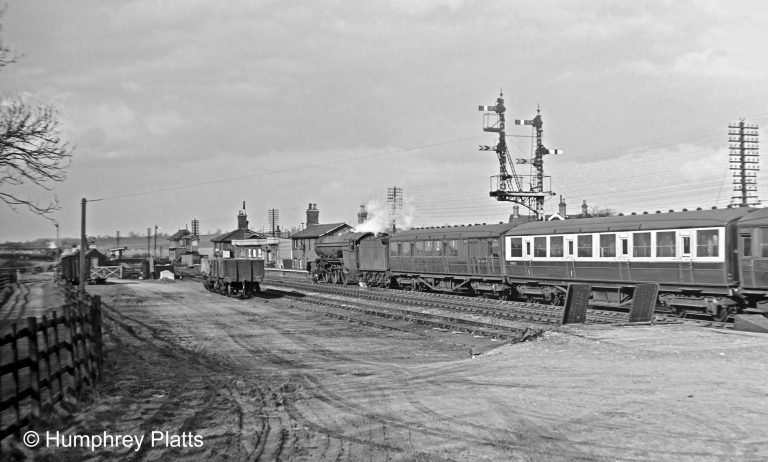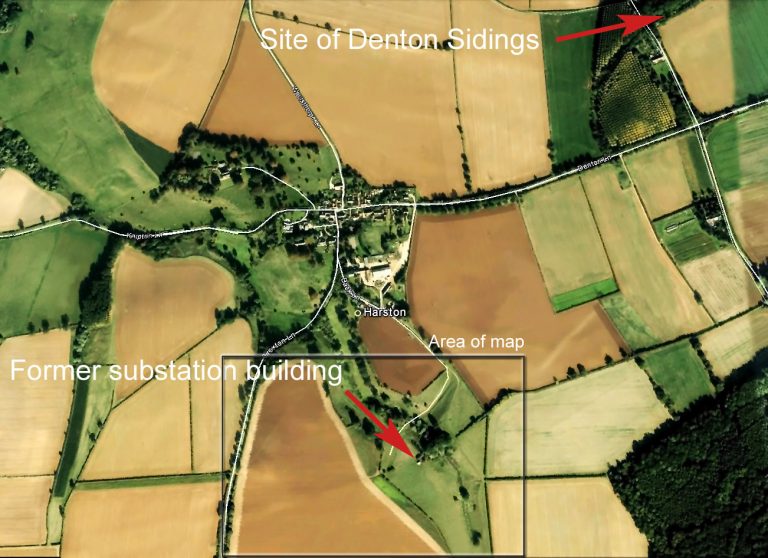We introduce the crew, their O2 locomotive and a short but intensively used section of the East Coast Main Line as we ride on the footplate with Colin Walker between Grantham South and Highdyke. Travel back to a winter's day in the early 1960s to join them on our latest new page here.
Tag: Grantham
Steve Taylor and John ‘Jock’ Michael
We were very sorry to receive in recent weeks the sad news that these two former Grantham footplatemen have passed away.
Steve and John both appear below in a photograph of former Grantham footplate crew which was taken during the visit of the world speed record holding A4 locomotive Mallard to the Festival of Speed held in the town in September 2013.

Back row (L to R): Tony Stevens, Syd North, Phil Cunnington, Steve Taylor, John Plummer, Maurice Massingham, Don Wade, Roy Veasey, Arthur Curtis
Front Row (L to R): George Fielding, Mick Gibson, Roy Vinter, Alan Grummitt, John Michael, Ken Willetts, Boris Bennett (in front), Nev Eldred
Photograph taken by Nick Pigott
Steve Taylor was a cleaner and fireman at Grantham Loco in the 1950s-early 1960s period. Friend and colleague Roy Vinter tells us that 'Steve and I started cleaning the same year, were the same age and went to King's X shed at the same time on loan, indeed we shared a flat with another lad in Finsbury Park for a while.'
Steve went back to Grantham after 6 months, but Roy stayed on in London as he recalls in his page here. When Roy was still working from King's Cross shed, Steve came onto the footplate of No. 60007 Sir Nigel Gresley at Grantham early one morning as Roy and his driver were preparing for the return trip. He 'built up the back corners' of the firebox with coal so as to give Roy a good start for the journey.

Photograph taken by Ted Pizer, signalman at Colsterworth Mines.
John Angus Michael, known as 'Jock' to his railway colleagues and friends, came from the Isle of Skye to Grantham as a young man to work on the LNER. John loved the job, describing how the footplate of a railway locomotive was a special place where the team of driver and fireman held a unique position of responsibility. Writing to us in June 2015 he describes how he felt soon after starting out as a cleaner. 'Seniority meant so much to us in those days. Looking longingly from the lower rungs of the ladder to the dizzying heights of the top link and the rich rewards and status attainable there.'
In 2017 John kindly lent us some photographs taken in 1959, when the Grantham Loco Mutual Improvement Class arranged an outing to the Romney Hythe & Dymchurch Railway in Kent. He told us then - rather poignantly - that he was the only man in the photos who was still living. They are on our page here, along with John's typically amusing account of the trip and more photographs of the day lent by the late Boris Bennett.
John succeeded in attaining the position to which he aspired as a young man, retiring from the railway as a highly respected Grantham driver. He is third from right in the photograph below, which was taken in May 1990 on the closure of the Train Crew Depot at the station.

Back row: Pete Nicholls (Examiner), Maurice Massingham, Jack Tuckwood, Ray Green, M. (Hodge) Collingwood, Roy Evans.
Front row: Michael A. (Ma) Brown, Fred Burrows (retired), John Phillips, Denis (Danny) Wright, John (Jock) Michael, Gerry Edwards (retired).
Photograph kindly lent by Maurice Massingham.
John lent his support to Tracks through Grantham in many ways. He always had a word of encouragement for Mel and me at our six-monthly gatherings at the Railway Club. To quote once more from his letter of 2015, John is referring to a recent get-together when he says, 'Forgive me, John, for reminiscing, but it is so good to meet the few of us who are left and who loved our hard graft with a passion.'
John Michael's funeral will be held in Grantham on Wednesday 21st August. Here is a link to the family announcement.
John Clayson
People and Incidents at Grantham South Box
For nearly 100 years signalmen and telegraph lads at Grantham South signal box kept watch over the running lines, the yards and the sidings which lay south of the passenger station. The box was staffed round the clock, seven days a week. What stories it might have told of the characters who worked it, and some of the incidents they dealt with!
Although the building is long gone, former Grantham signalling staff have generously shared their memories and photographs. We've also researched local newspapers and explored other sources to illustrate the work of signalmen and telegraph lads at Grantham South.
The stories include:
- an insight from Victorian times into the harsh and, from a modern perspective, negligent attitude of the railway companies to the personal safety of their employees;
- the tale of a horse which made a bid for freedom by charging along the main line as far as Great Ponton;
- how, one September night in 1906, two men on duty at the South Box were the first to witness the Scotch mail train emerge from the darkness as it sped towards the station out of control to meet with destruction a few seconds later;
- a surprising episode in the summer of 1911, during a national dispute over working conditions on the railways, when the South Box was surrounded by a riotous mob which had to be dispersed by police.
Read all of this and more in our latest new page Grantham South signal box - people and incidents .
Early Railcars (Diesel Multiple Units) in Grantham & Lincolnshire
In our introductory article, that covered the early main line diesel scene at Grantham, we briefly looked at some of the reasons behind the transition from steam to diesel power on Britain's railway system, in particular the main line through Grantham. But what about the cross country secondary lines that linked Grantham with other urban areas, such as Lincoln and Nottingham? Our next article is all about the introduction of 'Railcars' during the diesel era and has just been published.
Can you remember the first generation Railcars? Perhaps you referred to them as Diesel Multiple Units, or maybe DMUs for short? Our new article begins here.
A view of Grantham from Doncaster
In February 1980 Doncaster Power Signal Box extended its area of operation to include Grantham. In our latest new feature Andy Overton provides a unique insight into the work of signalling in a power box, including the vital role of communication with station staff at Grantham. There's also the frustration of prioritising train movements effectively through an over-rationalised track layout in the era of the privatised railway. It's a fascinating read.
More railways rediscovered: the High Dyke Branch
Need to shake off the winter blues?
Why not rediscover the High Dyke Branch!
Surely, following our recent spell of Siberian weather, spring will soon be in the air. If you fancy getting out and about while rediscovering some railway heritage let our new page, The High Dyke Branch Rediscovered - Part 1, be your guide.
John Pegg will show you the first 3 miles of the former branch line, from Highdyke Junction to the Great North Road near Colsterworth. There's a great selection of photographs . Most show scenes taken in summer 2017 but, mixed in, are some 'flashbacks' to the 1960s and the early 1970s when the line was still moving heavy loads of ironstone to the main line, the job it was built for in 1916-19.
So why not find your boots, burn off a few excess calories and clear away the cobwebs?
...and look out for Part 2 soon.
Stoke signal box
For our latest new page we move to one of the boundaries of the Tracks through Grantham 'sphere of interest' in terms of railway geography and infrastructure.
'Stoke Bank' is a legendary location, comprehensively written into East Coast Main Line history as one of the world's most renowned railway racing stretches where speed records have been made and broken.
But what about the signal box at the start of the descent (or, equally, at the summit of the ascent from both directions)? Many a train timer's stopwatch has clicked there, but few travellers spared much of a thought for the men on duty at Stoke box as they sped past. Many a loco crew, short of steam on a poor engine, have been thankful when the gradient changed from adverse to favourable as they exchanged a wave with the signalman at the isolated outpost.
A Long Apprenticeship
Fred Harris joined the railway at Grantham in August 1955. He achieved promotion to driver nearly 30 years later in April 1985, hence the title of the story of his working life on the railway. Read how a youthful Fred and his driver peered into dense fog one night from the footplate of a slowly advancing 'Tango', looking for signals that were no longer there. How does a footplate crew respond as a 'Green Arrow' begins to self-destruct at speed on the East Coast Main Line? Enjoy with Fred a week away at Bridgnorth refreshing his steam skills. All this and more in our latest new page.
Another Barkston Discovery
Humphrey Platts recently discovered another very attractive photograph, one of a series of three he took while at Barkston Station one day in the 1950s. We've just added it to his Gallery page - scroll down to the third image following the introduction.
Ironstone Mining Rediscoveries
Keeping an eye on the user statistics for Tracks Through Grantham we're used to seeing an occasional surge in interest when we publish a new page. However, around the middle of July there was a sudden spike in our viewing figures which wasn't set off by new content. It was thanks to a favourable mention on RMweb of our Railways Rediscovered pages (about the former Woolsthorpe Branch) that, for a period of three days we practically trebled our normal readership.* If you'd like to see what the RMweb contributors had to say you can find the start of the thread here.
Also recently, Richard Marshall was in touch, leaving a comment on our page The Woolsthorpe Branch Rediscovered – Part 2 and subsequently he sent us some photographs of a building which was connected with the ironstone quarries and remains standing today, near Harston. You can discover the building by scrolling down to near the bottom of this page.
(* We should clarify that the site stats do not tell us who our users are. They give the total number of views of each page per day and some indication of how those users have found Tracks through Grantham.)








